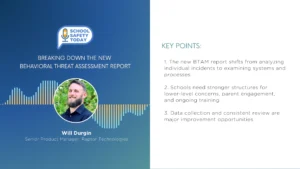SMART Upgrades Tech To Support Remote Learning
As teachers prepare to teach across virtual, hybrid, and in-person environments this semester, SMART Technologies — provider of the world’s most popular collaborative learning software and hardware — announced new software features and integrations that make it easier for teachers to build learning experiences that engage and support students from anywhere.
As the COVID-19 crisis forced schools to go virtual last semester, three quarters of teachers in an Education Week survey reported a decline in student engagement after switching to remote learning. Likewise, thousands of schools across the country are now returning to hybrid learning environments, in which teachers will simultaneously teach students in the classroom and at home, creating new demands for student engagement across multiple modalities.
New integrations with widely-used platforms like Google and Microsoft enable teachers to use SMART software, without reliance on the SMART Board® or flat panel, to enhance instruction from directly within the platforms and workflows they already use. Lesson pacing control allows teachers to more easily manage their classroom and keep students on task while still enabling differentiated learning. Additionally, two new features allow teachers to personalize instruction and feedback through voice recordings and obtain insight into individual student work in group settings. The new integrations make it easier for students to navigate remote learning, freeing up teacher time to focus on learning moments instead of troubleshooting technology.
“Being able to send something out to a student, let them work on it, while the teacher can check in and see what they’re doing in real time is really powerful,” said Drew Morgan, Coordinator of Secondary Curriculum and Professional Development at Auburn City Schools in Alabama. “Especially now with distance learning, I love that there’s no context change. The more you ask learners, especially younger ones, to navigate to different browsers or windows, the more you can lose kids.”
SMART Learning Suite Online is a cloud-based platform used by millions of teachers globally to build and deliver engaging content and game-based activities, activate easy-to-use formative assessments, and enable student collaboration and breakout groups through any device, anywhere. Students are able to connect and work independently or with peers, in real-time or on their own time, making it possible to take charge of their learning while clearly showing their progress.
The new integrations include:
- Microsoft Teams™: SLS Online gives teachers a richer way to deliver lessons in Microsoft Teams – especially while video conferencing. More than just screensharing, students can join interactive SLS online lessons created from existing learning content such as PDFs, PowerPoint files, and YouTube videos, that can be augmented with digital whiteboards, formative assessments and much more. Teachers can easily create Teams assignments and share lesson files with their students and colleagues. This integration makes it possible for the whole class to connect and participate in lessons and assignments all within the Teams platform.
- Google’s G Suite for Education: Teachers can create and launch lessons directly from Google Drive, combining existing lesson material such as Google Slides, PDFs and YouTube videos with formative assessments, digital whiteboards, game-based activities and more, all within the same lesson file, and easily give feedback to students in real time. Teachers can easily create assignments in Google Classroom, and utilize their existing Google Drive workflows to organize and manage lessons.
- Canvas LMS: SMART’s Google Drive integration enables users of both G Suite and Canvas to access and assign SLS Online lessons in Canvas in the same way that G Suite documents are accessed and assigned, giving them easy access to all the great teaching and learning benefits of SMART Learning Suite Online.
- ClassLink and One Roster: These integrations enable administrators to use teacher lists from Microsoft, Google, or ClassLink through OneRoster to automatically and securely provision SMART Learning Suite.
“We know engaging and retaining students is top of mind for educators. Teachers are relying on our software to help bring into students’ homes classroom experiences like collaborating with peers or getting real-time feedback,” said Nicholas Svensson, SMART’s Chief Executive Officer. “Our new integrations with Google, Microsoft, and Canvas are designed to help educators simplify all the toggling back and forth between technologies and instead focus on inspiring and encouraging our learners in such uncertain times.”
Additional SMART Learning Suite tools make the software more powerful, especially for teachers delivering instruction in asynchronous settings:
- The Instructional Audio feature lets teachers add their voice to any lesson page, providing verbal explanations and instruction for more interactive and supported teaching anywhere. Adding teacher voice will bring screens to life, foster social-emotional learning, support a literacy-rich teaching environment, and help auditory learners get the exact instruction they need.
- A new Workplace Attribution tool helps teachers monitor and evaluate individual student work within collaborative small group or whole class learning experiences. SMART’s software displays which students have added and edited items in a shared workspace, providing insight into learning and increasing student accountability.
- In addition to the existing bank of content and activities on the platform, the SMART Exchange provides teachers with access to a library of teacher-created lessons, games, and activities that can be easily customized.









